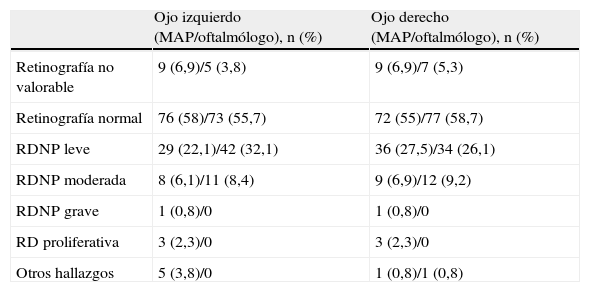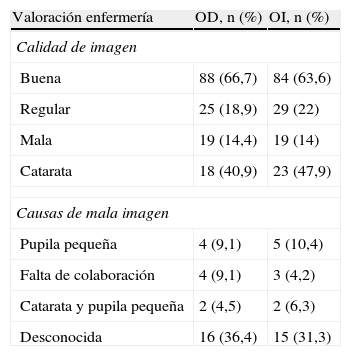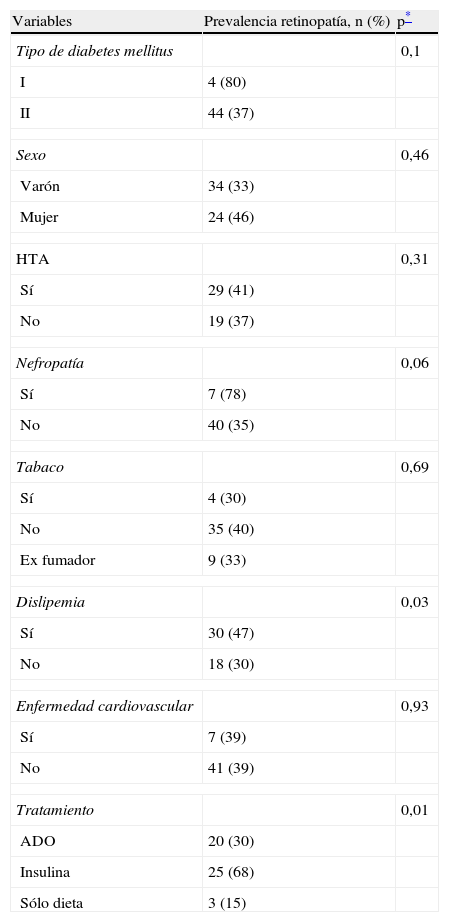Conocer la cobertura de realización de fondo de ojo del periodo de estudio respecto al año anterior. Conocer la prevalencia de retinopatía diabética y el grado de concordancia en la interpretación de las retinografías realizadas entre el médico de atención primaria y el oftalmólogo. Conocer la relación de las diferentes variables con la prevalencia de retinopatía. Describir los problemas detectados en el manejo del retinógrafo digital. Determinar prevalencia de PIO elevada en los pacientes diabéticos.
MétodoEn la zona de salud de San Esteban de Gormaz (Soria), se realizó un estudio descriptivo observacional a pacientes diabéticos. El personal de enfermería llevó a cabo un cribado ocular que incluía retinografía y tonometría.
ResultadosSe ha aumentado a un 50% (133) la cobertura de diabéticos que se han sometido al cribado ocular. El 38% (44) de los pacientes estudiados presentó algún grado de retinopatía y la calidad de las imágenes obtenidas en un 67% (88) fue buena. La concordancia en la interpretación fue moderada. El tipo de diabetes y de tratamiento, la presencia de dislipemia y nefropatía y los años de evolución y la glucohemoglobina elevada son variables que presentaron diferencias estadísticamente significativas. La cifra de presión intraocular media ha sido 14,66 mmHg; el 5% (6) presentó cifras>21 mmHg.
ConclusionesLa realización de un cribado ocular integral a los pacientes diabéticos se debe consolidar como intervención a implementar en atención primaria y remitir a especializada solamente a los pacientes con criterios de derivación, los casos dudosos y los fracasos de la técnica.
To determine the frequency of eye fundus examinations during the study period compared to the previous year. To find out the prevalence of diabetic retinopathy and the level of agreement between the primary care doctor and the ophthalmologist in the interpration of retinographies performed. To determine the relationship of the different variables with the prevalence of retinopathy. To describe the problems detected in the handling of the digital retinograph. And finally to determine the prevalence of increased intraocular pressure (IOP) in diabetic patients.
MethodsIn the wellness area S. Gormaz Esteban (Soria, Spain) we performed a descriptive observational study on patients with diabetes. The nurse conducted a visual screening that included retinography and tonometry.
ResultsThere was moderate agreement in interpretation of retinographs. The coverage of diabetes who have undergone eye screening has increased to 50% (133). Some degree of retinopathy was seen in 38% (44) of the patients studied and the quality of images obtained in 67% (88) was good. The type of diabetes and treatment, the presence of dyslipidemia and nephropathy and years of evolution and elevated glycated haemoglobin are statistically significant variables. The mean IOP was 14.66 mmHg, and 5% (6) had levels >21 mmHg.
ConclusionsThe implementation of comprehensive eye screening for diabetic patients should be consolidated as an intervention in primary care and referring only patients with specialized referral criteria, doubtful cases and technical failures.
Artículo
Comprando el artículo el PDF del mismo podrá ser descargado
Precio 19,34 €
Comprar ahora









